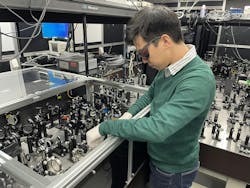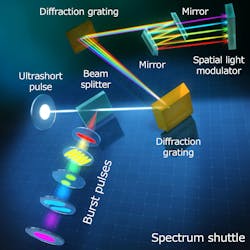An optical “spectrum shuttle” technique created by a team of researchers from the University of Tokyo and Saitama University simultaneously enables the production of gigahertz (GHz) burst pulses—intervals from -0.01 to -10 ns—and custom tailoring of their spatial profiles. This technique is powerful for various laser applications, such as spatiotemporal manipulation of laser ablation and advanced ultrafast photography within GHz regions (see video).
The team’s work producing GHz burst pulses was motivated by a broad range of applications for ultrafast photography, laser processing, and acoustic wave generation—and a lack of a good way to generate GHz burst pulses.
“We focused on generating burst pulses with intervals ranging from tens of picoseconds to nanoseconds,” explains Keitaro Shimada, a bioengineering Ph.D. student at the University of Tokyo (see Fig. 1). “While these timescales are important for ultrafast processes, there was a lack of technology to produce such pulses. Previous methods like fiber-based or large mirror techniques had issues with undesired nonlinear effects or less optical efficiency. Beyond this, the pulse intervals of burst pulses are too short for electric devices to perform independent manipulation of the spatial profile of each pulse.”
Spectrum shuttle
To overcome these challenges, the researchers created a spectrum shuttle—which produces GHz burst pulses from an ultrashort pulse (see Fig. 2). “Our optical system uses a combination of conventional mirrors, diffraction gratings, and spatial light modulators, but has a unique optical path arrangement designed in a three-dimensional (3D) configuration,” says Shimada.
How does it work? A single ultrashort pulse is spectrally dispersed horizontally by two diffraction gratings and spatially separated into different wavelengths via a pair of parallel mirrors. These separated, vertically aligned pulses obtain time delays corresponding to the number of round trips within the parallel mirrors. Separated pulses are then modulated at different areas of a spatial light modulator and return along their original optical path. These processes produce GHz burst pulses of varying wavelengths and uniquely shaped spatial profiles.
Putting the spectrum shuttle to the test
To demonstrate the basic performance of their spectrum shuttle method, the team produced GHz burst pulses from a single pulse at intervals of 0.1 to 3 ns. They spatially shaped successive GHz burst pulses individually by shifting the peak position or splitting its peak pulse by pulse.
And they put the spectrum shuttle to an ultrafast spectrographic imaging test in 800 and 400 nm wavelength bands to capture plasma and shockwave dynamics during ultrafast laser ablation with 250 ps frame intervals.
“Even with general optical elements, by expanding the design of an optical setup to a 3D optical configuration, we’ve created a new optical system that enables us to produce and shape GHz burst pulses,” says Shimada. “Our simple optical setup will allow many users to build and modify it easily to meet their needs.”
A significant challenge for the team along the way was achieving spatiotemporal manipulation of burst pulses within the GHz domain, such as individual shaping of burst pulses and tuning of time intervals of burst pulses, which is difficult to attain via electrical manipulation.
“The response speed of electric devices is too slow to manipulate the GHz burst pulses, but we overcome this by all-optical manipulation achieved by our spectrum shuttle’s configuration that simultaneously satisfies these two functions,” says Shimada.
Wide range of applications
The spectrum shuttle method opens the door to breakthroughs in ultrafast photography, which is crucial for exploring fast phenomena at a subnanosecond to nanosecond scale—and it can potentially revolutionize the way fast processes are monitored for many industrial applications.
“Its ability to individually shape GHz burst pulses also opens up new possibilities for precision laser processing, particularly semiconductor and metal fabrication, and holds significant promise optimizing laser surgery for medical applications,” says Shimada. “Our system involves placing six optical elements within a space of several hundred millimeters. This compact nature also suggests it’s portable and versatile for a wide range of scientific research facilities and industrial applications.”
What’s next? Shimada plans to now apply this technology to the laser processing of biomaterials and laser surgery. “Laser irradiation on inhomogeneous materials like biomaterials and biological tissues induces complex and nonreproducible processes,” he says. “We expect the spectrum shuttle’s ability to produce spatiotemporally tunable burst pulses and its ability to be applied to single-shot ultrafast imaging will lead to developing and improving laser technologies within the biomedical field.”
FURTHER READING
K. Shimada et al., Adv. Photon. Nexus, 3, 1, 016002 (Dec. 15, 2023); https://doi.org/10.1117/1.apn.3.1.016002.


